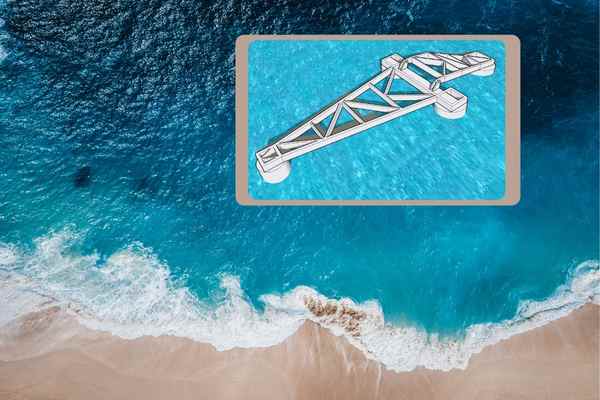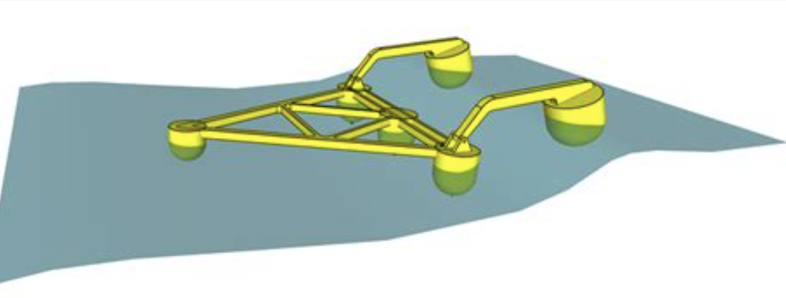Aussie wave power heads west
A large yellow renewable energy prototype will soon be riding waves in Western Australia.

Albany's aquaculture industry will draw energy from waves pounding Western Australia's southern coast in a demonstration project launching this month.
The giant yellow rig - a prototype version of the M4 wave energy converter - is ready to launch and will operate for six months over the summer at King George Sound on the southern-most tip of Western Australia.
Wave power has proven notoriously difficult to harness owing partly to the intense forces generated by ocean currents as well as its often remote location, far from grid infrastructure.
The prototype-scale M4 (Moored MultiModal Multibody) will float on the surface, fixed in place by large buoys. A hinged steel frame generates energy from the motion of the waves and the electricity created will power a coastal microgrid for the aquaculture industry.
The project will also assess the power of the waves in the Great Southern region, which boasts a high-wave energy density and reliable swells, and their feasibility for decarbonising local industry.
"This project will make all data publicly available to advance the entire industry sector – a point of difference to projects around the world where commercial sensitivities limit knowledge sharing."
It’s the latest in a series of wave energy pilot-scale projects, with no large commercial wave energy projects as yet established in Australia.
In 2015, CETO wave energy units operated by Carnegie Clean Energy were installed off Garden Island as part of the Perth Wave Energy Project, which, at the time, was hailed as the world's first commercial-scale grid-connected wave energy array.
The project used large, submerged buoys which bobbed with the waves to move pumps to pressurise water, generating both electricity and desalinated water.
The demonstration project operated for one year and produced power and fresh water for Australia’s largest naval base, HMAS Stirling.
Carnegie said it had applied lessons learned from the project to its commercial scale CETO 6 unit, and the Freemantle company now has subsidiaries in the UK, Ireland and Spain.
Inspired by nature
In 2021, a multi-million-dollar wave energy project was commissioned at King Island in Tasmania. The Uniwave prototype, which resembled a large catamaran, was developed by Melbourne-based Wave Swell Energy and supplied Tasmania’s grid, marking the first time that wave energy was used to power Australian homes.
The prototype, with its oscillating water column, was inspired by a coastal blowhole. With this design, the rising and falling water forces air to pass by a turbine at the top of the chamber, generating electricity.
The unit was decommissioned in late 2022, having operated successfully for over a year, and Wave Swell Energy says it will take its designs overseas where it believes the political appetite for new energy technology is stronger.
Waves are generated by the wind as it blows across the sea surface and wave converter devices seek to capture this energy. The CSIRO says its projections show that wave energy could provide a viable contribution to Australia's future energy mix.
“Our preliminary studies show the southern coastline of Australia has a great wave resource. This is because strong Southern Ocean winds generate consistently large waves which travel northwards to Australia's southern coastline. The large consistent swell provides ideal conditions for wave energy production.”
The new wave
The M4 project is government-backed and is a partnership between the University of Western Australia’s Marine Energy Research Australia (MERA), the government-funded Blue Economy Cooperative Research Centre, and the WA Government Department of Primary Industries and Regional Development.
Other collaborators are M4 Wave Power, BMT, Huon Aquaculture, Albany Shellfish Hatchery, University of Tasmania, University of Queensland, and Climate-KIC Australia/The Australian Ocean Energy Group.

"This project will make all data publicly available to advance the entire industry sector – a point of difference to projects around the world where commercial sensitivities limit knowledge sharing," MERA centre manager Dr Wiebke Ebeling said.
As well as demonstrating the efficiency of the technology, the project aims to test the potential of the region’s wave power to supply electricity to the local economy, which includes operations such as the Albany Shellfish Hatchery and Albany’s historic Whaling Station on the Torndirrup Peninsula.
Electricity from wave action will be supplemented by two small wind turbines and a solar array. A grid connection point at the Albany Windfarm at Moodrenup/Sandpatch already exists and could accommodate a future full-size wave energy converter.
The MultiMode Multibody (M4) device, which was developed by M4 Wave Power at the University of Manchester, UK, is a surface-riding wave power system with a flexing hinge, making it an attenuator type of wave energy converter. It consists of multiple floats connected by beams above the water, with two frame segments on floater buoys. It generates electricity through the flexing motion in the hinge. A centre float hinge allows relative rotation between the front and rear beams, producing power from this angular rotation under wave action. A single point mooring and the relative sizing of the floats allow the structure to naturally weathervane.





